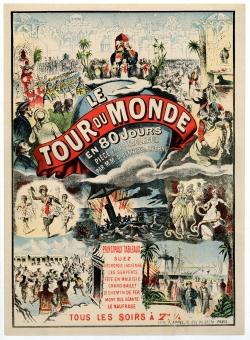Popularisation enables scientific knowledge to be disseminated to a wide audience by using clear, accessible language. After 1855, the audience in question was the same that frequented World’s Fairs and science and technology museums, read specialised publications and journals and attended scientific conferences.
In the 19th century, French society underwent far-reaching changes: the industrial revolutions transformed production methods, social organisation and everyday life. Technology was omnipresent, promising and disturbing in equal measure.
Science and technology also began to play a major role in publications aimed at young people. Around 1860, in order to respond to the fascination exerted by the world of science, a new literary genre s emerged: the “scientific novel”, combining gripping stories with educational input. The genre was popularised in 1863 by Édition Hetzel’s publication of Jules Verne’s novel Five Weeks in a Balloon, which aimed to provide “instruction that entertains”.
In the preface to the novel The Adventures of Captain Hatteras (1866), Pierre-Jules Hetzel, Jules Verne publisher, describes the author’s commitment to providing educational entertainment: “[…] His aim is to outline all the geographical, geological, physical and astronomical knowledge amassed by modern science and to recount, in an entertaining and picturesque format that is his own, the history of the universe”.
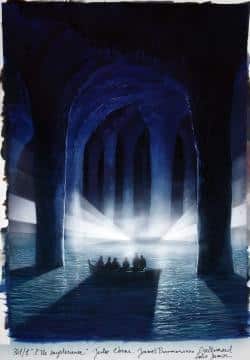
Jame’s Prunier
The Mysterious Island
Illustrations for adaptation of the novel novel The Mysterious Island
Gallimard Jeunesse publishing house, 2000
Gouache and watercolour on paper
MJV C567 (Purchased from the artist with support from the Fonds régional d’acquisition pour les bibliothèques, 2006)
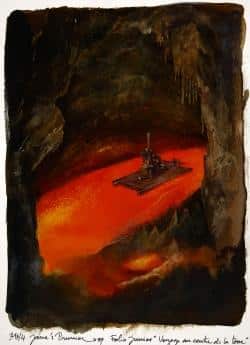
Jame’s Prunier
Journey to the Centre of the Earth
Illustration for the adaptation of Jules Verne’s novel Journey to the Centre of the Earth
Gallimard Jeunesse publishing house, 2004
Gouache and watercolour on paper
MJV C566 (Purchased from the artist, 2006)
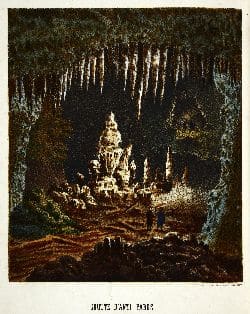
Munerelle
The Phenomena and Curiosities of Nature
Illustration by Lemaître
Derivaux, Strasbourg, 1856
MJV A4291
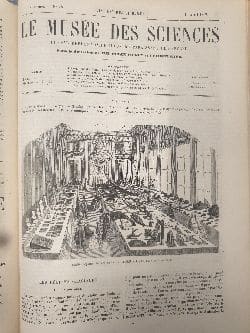
Le Musée des Sciences
Weekly magazine, 1 April 1857
MJV A878
In 1855, the first Paris World’s Fair fascinated the whole of France. The stir caused by the event led the journalist Henri Lecouturier to launch two new magazines, La Science Pour Tous and Le Musée des Sciences, in 1856.
The 19th century, over-hastily described as “scientific”, might better be characterised as “popularising”.
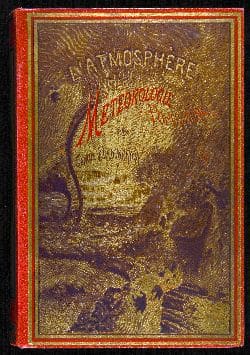
Camille Flammarion
The Atmosphere: Popular Meteorology
Librairie Hachette, Paris 1888
MJV A5738

Jules Verne
Journey to the Centre of the Earth
Éditions Hetzel, Paris, 1875-1890
MJV A380
The ongoing development of natural history inspired the author for this second Extraordinary Voyage. There were two editions of the book, the first in 1864 and the second in 1867, with two additional chapters containing episodes that updated advances in scientific discoveries, in particular in the field of palaeontology.

Jules Verne
The Voyages and Adventures of Captain Hatteras
Éditions Hetzel, Paris, 1898
MJV A382
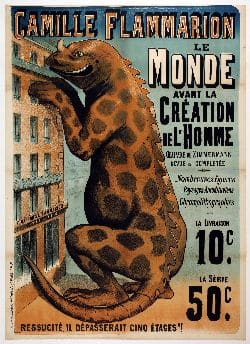
Promotional poster for the publication of
The World before the Creation of Man
Éditions Flammarion, Paris, 1885
MJV D1033
The natural sciences developed significantly over the course of the 19th century. Great voyages of exploration revealed the world’s diversity and the variety of living species, while geology provided information on the Earth’s age and the changes it has gone through. Palaeontology, the study of fossils, revealed the beginnings of life and the existence of long extinct species such as the dinosaurs. And the theory of evolution did much to change our conception of humankind, its origins and its place in nature.
In The World before the Creation of Man, Camille Flammarion takes up the work started by W.F.A. Zimmermann in the 18th century. He popularises palaeontology and shows himself to be a defender of the theory of evolution that Charles Darwin put forward in his book The Origin of Species, published in 1859.

Jean Carzou
From the Earth to the Moon
Librairie Hachette, Paris, 1969
MJV A3171
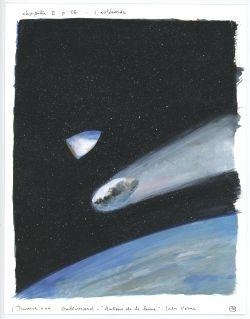
Jame’s Prunier
Around the Moon
Gouache and watercolour on paper
Illustrations for the Gallimard edition, 2004
MJV C355 (Purchased from the artist with the support of the Regional Acquisition Fund for Libraries, 2005)
Jules Verne’s adventure stories have left a visual impression on the collective imagination. His body of work continues to inspire authors and artists, resulting in a wide range of interpretations and the creation of countless news images.
The artist Jame’s Prunier has illustrated re-editions of two of Verne’s novels in succession, Around the World in Eighty Days in 1995 and Around the Moon in 2004. The artist’s compositions express Verne’s work in images. He interprets the narratives with a sense of realism and a concern for the atmosphere conjured up, in order to create a pleasing dialogue between text and illustration.
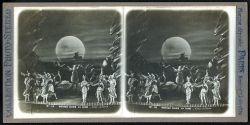
A Trip to the Moon
Circa 1879
(donation from the Friends of the Nantes library association, 2016)
Stereoscopic view representing the enchanted opera by Jacques Offenbach, libretto by Albert Vanloo, Eugène Leterrier and Arnold Mortier according to Jules Verne, created on October 26, 1875, at the Gaîté theatre. Stereoscopy refers to the techniques used to reproduced a perception of relief based on two flat images.
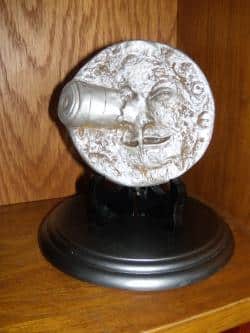
Jean-Marc Deschamps
Moon on stand
Model inspired by the film A Trip to the Moon
2000
MJV G193
A Trip to the Moon is a film produced and directed by Georges Méliès, released in 1902. It is inspired by the novels From the Earth to the Moon by Jules Verne (1865) and The First Men in the Moon by H.G. Wells.
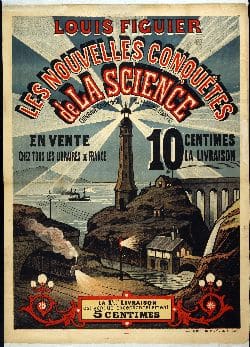
Promotional poster for the publication of
The New Conquests of Science
Imprimerie Robelin, Paris, 1884
MJV D1036
From the 1850s onwards, dissemination of popular science books enabled readers to familiarise themselves more easily with advances in science and technology.
Louis Figuier was one of the period’s major popularisers. The promotional poster for the publication of The New Conquests of Science encapsulates his book’s contents and evokes the era’s innovations: the development of the railway, the appearance of steamships, such major projects as construction of bridges and tunnels, and the omnipresence of electricity. Science is depicted symbolically, in the form of a lighthouse guiding humanity and spreading its light across the world.
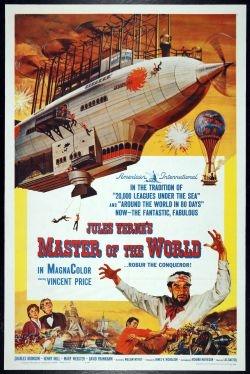
Master of the World
Poster for adaptation to the cinema
by director William Witney, 1961
MJV D290
American cinema helped promote the work of Jules Verne though the reputation of the actors, and the considerable technical and financial means employed. But what the work gained in prominence it lost in integrity: script writers changed the plots and introduced new characters.
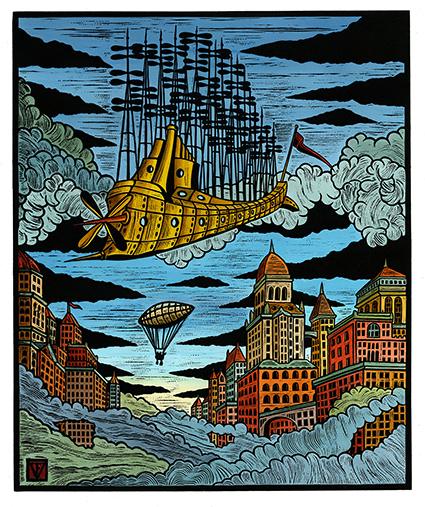
Frédéric Voisin
Robur the Conqueror
Linocut, 2020
(Purchased from the artist)
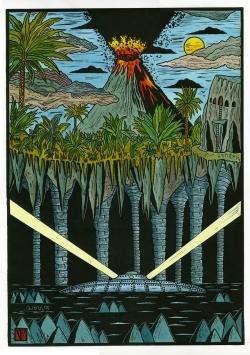
Frédéric Voisin
The Mysterious Island
Linocut, 2020
(Purchased from the artist, 2023)
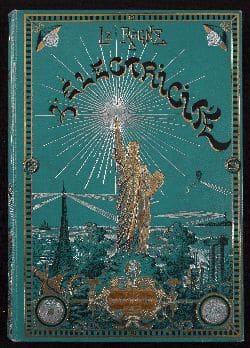
Gaston Bonnefont
The Reign of Electricity
Alfred Mame et fils, Tours, 1895
MJV A5595
In 1881, the first International Exhibition of Electricity was held at the Palace of Industry in Paris. Hundreds of thousands of visitors flocked to it to marvel at the wonders of the “Electricity Fairy”.
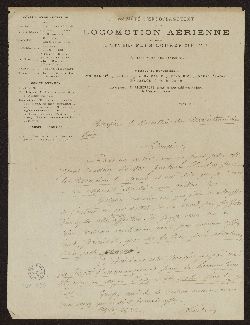
Félix Tournachon aka Nadar
Handwritten letter
MJV B25 (exhibition print)
The well-known photographer Nadar took an active part in the development of aviation and his interest greatly inspired Jules Verne’s writings.
In a letter written on headed paper from the “Society for the Encouragement of Aerial Locomotion by Means of Heavier-Than-Air-Machines”, a committee founded by Nadar in 1863, he takes the Director of the Le Moniteur universel du soir newspaper to task in reply to an article it had published and which seems to have been somewhat confused. He writes, “It says that I dream of an apparatus attached to a balloon”, “I cannot let this assertion pass. I spend my life saying, quite the contrary but not loud enough it would seem, that balloons are absolutely unsteerable.”
On the left side of the headed paper, the names of the committee members include Jules Verne, an active advocate of “heavier than air”.
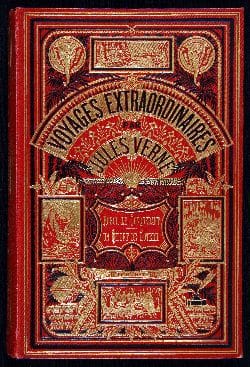
Jules Verne
Robur the Conqueror followed by The Lottery Ticket
Éditions Hetzel, Paris, 1886
MJV A345
The 19th century set off to conquer the air, the earth’s surface and the depths of the sea. A great deal of research was carried out with a view to increasing the speed and autonomy of means of transport and communication. Jules Verne’s originality did not lie in the technological invention of machines that had always been imagined by others before him, but in the extraordinary way he exploited them.

Jules Verne
From the Earth to the Moon
followed by Around the Moon
Éditions Hetzel, Paris, 1875-1878
MJV A314
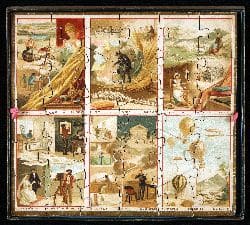
Puzzle game
Scientific Professions, Techniques and Advances
Chromolithograph on cardboard, circa 1890
MJV G375
This classic 19th-century game provided children with a playful approach to scientific knowledge.
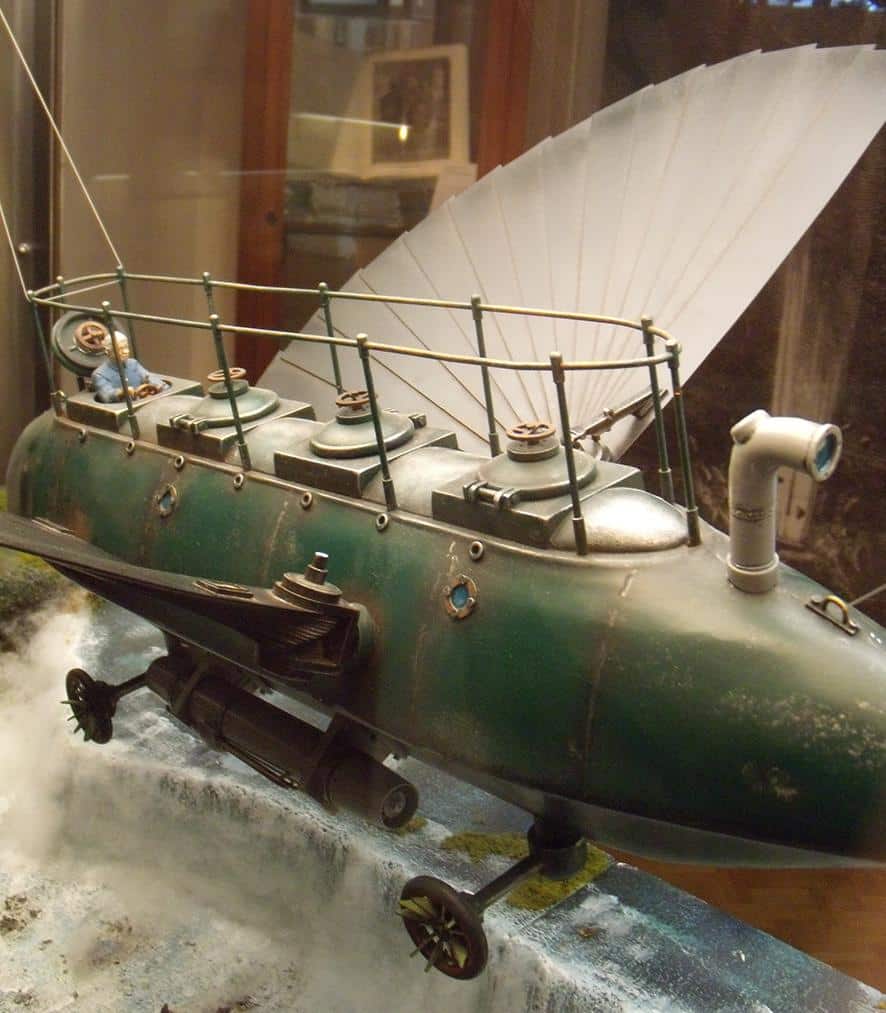
Jean-Marc Deschamp
The Terror, 2003
Model inspired by the novel Master of the World (1904)
MJVG172 (Purchased from the artist)
With Master of the World, Jules Verne completes a story begun twenty years earlier: the engineer Robur returns with a new machine and obscure projects.
The Terror is a « universal means of transport », a hybrid vehicle capable of moving on earth, on and under the water, and in the air. This curious machine takes the shape of a rocket-like aluminium structure (unlike the Albatross, Robur’s first vehicle, made from resin paper). The shell is placed on four wheels, and the spokes of the wheel widen into paddles to move faster on water. The wings are close against the sides of the vehicle; they are deployed at take-off, then start to flap like the wings of a bird. 10 metres long, 1.80 metres wide, the Terror exceeds 250 km/hour on land thanks to Parsons turbines placed each side of the which propel the vehicle in water and on land.
The Terror and its creator met a tragic end: they defied the elements and were struck by a vengeful lighting bolt and swallowed up in the depths of the Gulf of Mexico.
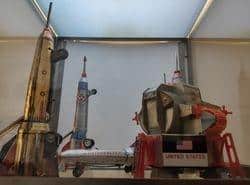
Selection of toys: The conquest of space
(André Martin collection)
With his stories From the Earth to the Moon (1865) and Around the Moon (1869) which describe propulsion and the orbiting around the Moon of a manned space craft, Jules Verne foretold the exploits of space programmes a century in advance. He can be considered as « one of the greatest pioneers of the space age » (Frank Borman, astronaut).
These objects illustrate the conquest of space and the race to the Moon undertaken by the united States and the USSR after the Second World War. Within the Cold War context, the launch of the artificial satellite Sputnik 1 and the first flight in space made by Youri Gagarine, demonstrated the dominance of the Soviets in this area. This rivalry led the United States to launch the Apollo programme with the aim of taking a man to the Moon. This ambitious project became reality on July 21, 1969, with the Apollo mission and the first steps on the moon by Neil Armstrong and Buzz Aldrin.
